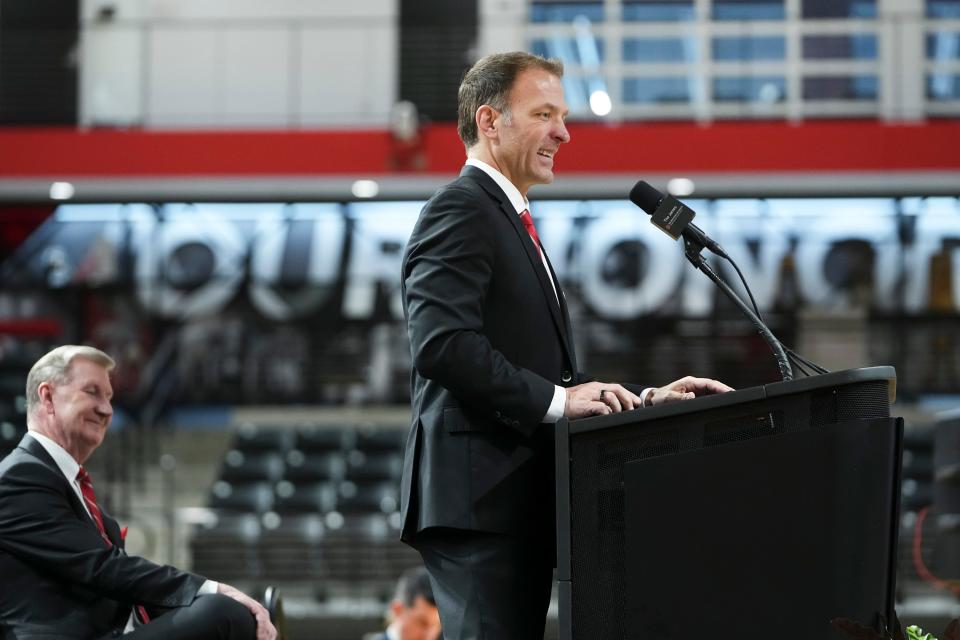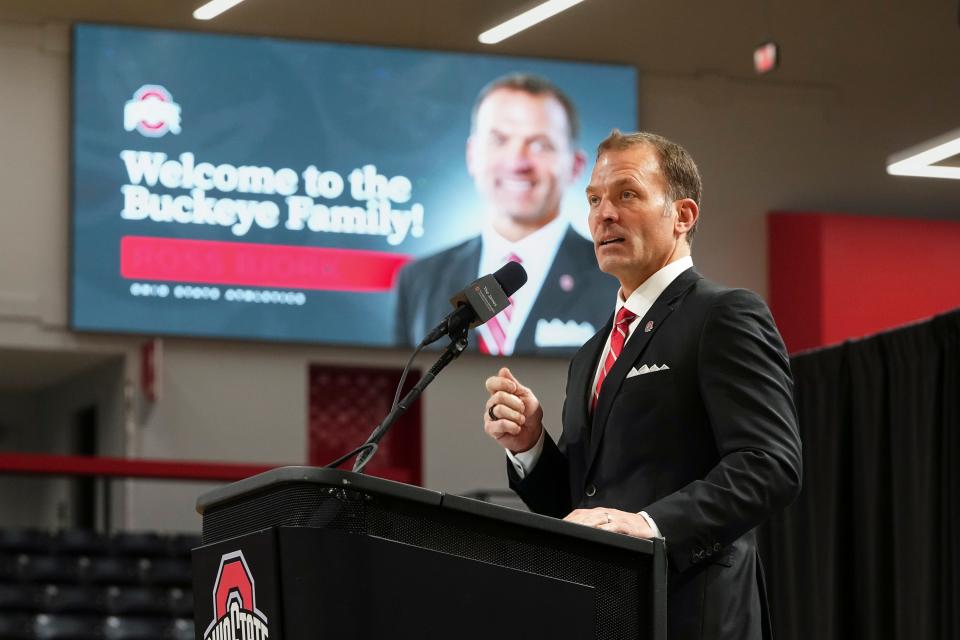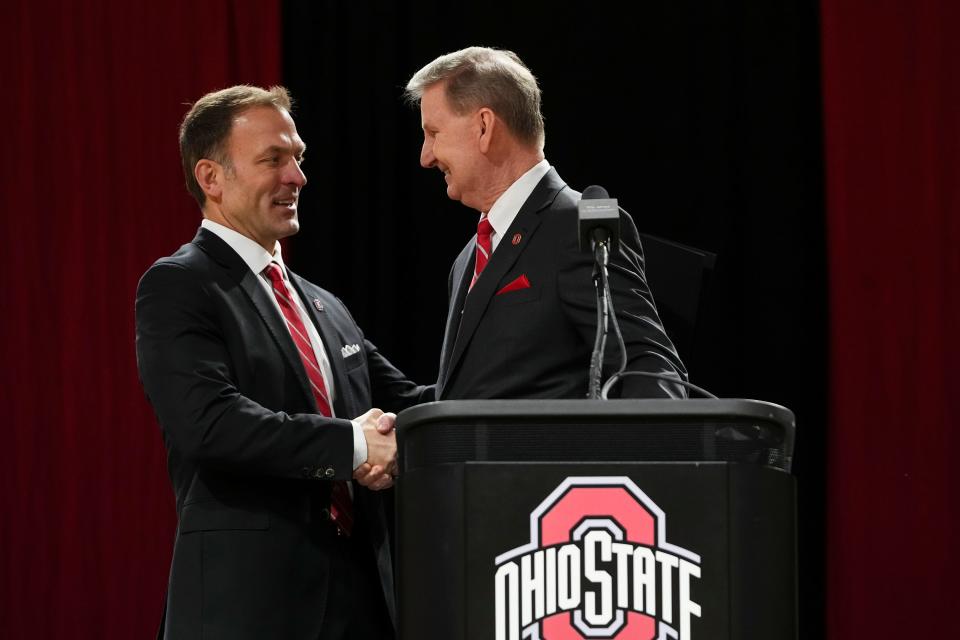Oller: Ross Bjork comes in as OSU athletic director sporting necessary thick skin
Ross Bjork did not realize it at the time, but the thick skin needed to survive as a college athletic director was beginning to be toughened in the tiny gymnasiums of small towns in east-central Kansas.
It was there, on the rural testing grounds of burgs such as Olpe, Waverly and Lebo, that Bjork first received blowback for his decision-making.
“Being a high school basketball official? I mean you’re getting yelled at by moms,” Bjork said Wednesday at his first news conference as Gene Smith’s replacement as Ohio State athletic director.
If the 51-year-old native of Dodge City, Kansas, could handle moms, dads and grandparents berating him for missing a call, or blowing the whistle at their little Billy, surely he could withstand the criticism of college fans blaming him for making the wrong coaching hire.

It also takes a cool customer to stand face to face with bad-breath high school coaches as they scream, “Where was the foul?” and calmly explain the situation. Bjork was that customer.
“I remember Ross being much more patient with the coaches than I was at the time,” said Brian Pracht, who worked basketball games with Ross to earn money outside their jobs in the Emporia State athletic department. That was 15 years before Pracht became an associate athletic director at Notre Dame.
“Fans sat on the stages. It was cramped quarters, hot, all of the above,” he said, recalling his days officiating alongside Bjork in the mid-1990s.

It was those heated moments with fans and coaches that prepared Bjork for the fan abuse he would later receive at Mississippi and Texas A&M. And for what eventually he will encounter at Ohio State, where putting up with irritated social media experts is part of the job.
“An (athletic director) job in the SEC and Big Ten is not for the faint of heart,” Bjork said Wednesday, explaining that the magnitude and visibility of the two conferences, combined with the intensity of social media involvement by passionate fans, makes working in the two most powerful conferences both challenging and rewarding.
“But this (Ohio State) job in particular,” he continued. “It’s the entire state. A public trust. Public accountability. Somebody better have the chops to handle this, because, one, you’re following a legend (in Smith); and, two, it’s the scope and scale. I know this is the largest fan base in the country. Data speaks to that.”
J.D. Campbell believes Bjork has the “chops” for the OSU job.
“His demeanor is the same today as it was as a player,” said Campbell, who worked in the Emporia State athletic department when Bjork played fullback for the Hornets in 1993-94. “He’s very composed. Very calm. And I have to believe everything he does is very thought out.”
Transferring from Dodge City Community College, Bjork arrived at Division II Emporia State as an undersized fullback with an oversized drive to excel. And a passion for punishing defenders.

Bjork may have been calm off the field, but as a fullback he saw his job as “to hit that guy and go hit that guy. There wasn’t a lot of creativity,” he said. “It was pretty simple. Just go knock that person out. So now when I see something, when I am inspired by something, I just want to go get it done.”
It makes perfect sense that Bjork played a position that in the 1990s was still seen as pivotal to offensive success.
“His career could be noted as somebody who was always about the team,” Pracht said. “Do whatever is necessary to get the job done. Playing fullback has become a lost art. His role was to help others on the field. Perhaps that’s a little bit poetic of being an athletic director today. Our job is to help others.”
Bjork outlined his reasons for wanting to “play fullback” as OSU’s athletic director.
“I made $600 a month at Western Kentucky in the summer of 1996,” he began, mentioning one of his first sports administration jobs after graduating from Emporia State. “I got a job at the University of Missouri in 1997 and thought I’d hit the lottery. I was making $18,500. When I met (wife) Sonya, she looked at the state salaries and I had gotten a raise to $20,000 and I’m like, ‘Man, she still likes me.’ ”
Bjork’s OSU contract is worth $2 million. That buys a lot of macaroni and cheese.
“It’s never been about the stage, the money,” he said. “It’s been about, ‘Can you make a difference? Can you serve and lead others? Can you be impactful on a broad scale?’ I would have been an AD at Emporia State, and maybe they’ll call me some day when I retire from Ohio State. The drive is internal.”
What sparked the passion? Bjork said it was always there but was fanned into flame by his Kansas upbringing, which has roots in Ohio. His mother, Linda, grew up on a farm in Williamstown, near Findlay. His dad, Carl, who passed away in 2021, was in the car business for 45 years. A parental combination of toughness and salesman ability – i.e. gift of gab – helped make Bjork who he is.

Those two attributes also merge in the day-to-day duties required of an athletic director, especially in a sports culture in which anyone with access to a cell phone or computer can criticize every decision and call for your job.
Bjork does not shy from the challenge.
“The bottom line as an athletic director, as a university administrator, is what is best for the institution? That’s the No. 1 filter,” he said, answering how he navigated difficult decision-making as the AD at Mississippi and Texas A&M.
He initially defended former Ole Miss football coach Hugh Freeze against NCAA recruiting allegations before Freeze was forced to resign when it was discovered he had used a university cell phone to call escort services. At A&M, Bjork extended football coach Jimbo Fisher’s guaranteed contract another 10 years, then fired him two years later, costing the school nearly $77 million.
“I’m the AD,” he said. “If anybody wants to blame anybody, blame me.”
And fans will. Football coaches get celebrated when they win and crucified when they lose. Athletic directors typically mostly just get criticized. When the social media mob comes for Bjork, and eventually it will, he won’t be intimidated. He knows the difference between legitimate beefs and crazy barroom banter.
“You have to look at it as ‘Is social media real life?’ I don’t know. For my kids, maybe,” he said, looking over at teen sons Payton and Paxton. “They see a lot of things. But everything is balance. Is there something real out there that you have to follow up on? Have to check out? There are people who can monitor those kinds of things to see if it gets out of hand.
“But at the end of the day, if we say it’s about our institution, it’s about our values. It’s about making the right decisions in the betterment of the program and student-athletes.”
Bjork paused, then spoke like the young basketball official he once was.
“If I make people mad, it probably means I made the right decision,” he said. “If I make people happy, it probably means I made the right decision.”
Don’t argue with the new OSU ref. Come July 1, he has the power to “T” you up, if not toss you from Buckeye Nation.
Get more Ohio State football news by listening to our podcasts
This article originally appeared on The Columbus Dispatch: Ohio State Buckeyes Ross Bjork groomed for AD job on Kansas hardcourts
